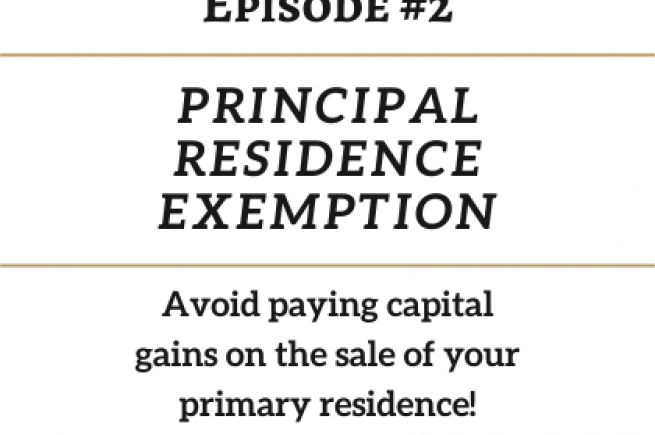Co-author: Kim Streuber, CPA
Selling your home is a big decision, and the tax impacts of such a large transaction should not be overlooked. Typically, when an asset is sold, the owner must pay tax on the increased value of the asset over the time they owned it, also known as a “capital gain”. In Canada, only half of the capital gains are taxable which is a huge tax relief. On top of that, a homeowner can eliminate some or all of the taxable capital gains when they sell their principal residence by utilizing the Principal Residence Exemption.
Understanding of Principal Residence Exemption requires an understanding of three elements: Capital Gains, Principal Residence and Principal Residence Exemption.
Capital Gains
A capital gain is the difference between the amount you paid for the property and the amount you received when you sold the property. So, there are two essential elements in calculating the capital gain: the selling price and the adjusted cost base of your property.
The selling price is easy: this is the amount you received when you sold the house.
The cost of your property is tricky because it is not the amount you paid, but the adjusted cost base. The adjusted cost base of a property is equal to the cost of a property plus acquisition expenses (commissions, legal fees), plus the cost of capital improvements. Note that capital improvements include major additions and improvements, not regular repair and maintenance expenses. Many of us don’t keep track of the various expenses that become part of the adjusted cost base of the property and when it is time to sell, especially if you own more than two properties, end up paying more tax than necessary. Tracking of expenses is also important in case you decide to rent the property later and the property no longer qualifies for principal residence exemption. You also need to have proper documentation for each expense item being included in the cost base, so save the receipts! I would recommend starting a separate file folder for each property and including the receipts for all the improvements and closing costs in the folder until the property is disposed.
If you are not sure if the expense is capital in nature, the CRA’s criteria for current and capital expenses for rental property can be used as a guide to determine if an expense is capital in nature: http://www.cra-arc.gc.ca/tx/bsnss/tpcs/rntl/crcp-eng.html.
As mentioned above, half of the capital gains are taxable in Canada. However, you can eliminate some or all the taxes on the principal residence through the use of principal residence exemption.
Principal Residence
A principal residence is a housing unit that is a house, a cottage, a condominium, an apartment in an apartment building, an apartment in a duplex, a trailer, mobile home or a houseboat.
In addition, the housing unit must meet the following four conditions each year to be designated as a principal residence:
It is a housing unit, a leasehold interest in a housing unit, or a share of the capital stock of a co-operative housing corporation you acquire only to get the right to inhabit a housing unit owned by that corporation.
You own the property alone or jointly with another person.
You, your current or former spouse or common-law partner, or any of your children lived in it at some time during the year.
You designate the property as your principal residence.
Caveat on land: Only ½ hectare of land can be included as part of your principal residence. If you own more land, it may be included as part of your principal residence if you can show that you need more land to enjoy your home or at the time you bought the land, the minimum size imposed by the municipality was larger than ½ hectare.
When you sell your home that you are planning to designate as a principal residence for tax purposes, some or all of the taxes can be eliminated through the use of Principal Residence Exemption.
Principal Residence Exemption (PRE)
In order to use the principal residence exemption: you must designate the property being sold as your principal residence, and you can only designate one property that you own as your principal residence each year.
Therefore, if you owned two or more properties at the same time, you must decide which property you should designate as a principal residence each year to decrease your tax obligation. We’ll get into those calculations later in the article.
The principal residence exemption is calculated as follows:
(Number of years designated as principal residence + 1) X Total Capital Gain = PRE
Total number of years owned
Based on this calculation, if you designated the property being sold as your principal residence each year you owned it (or one year less), you would eliminate 100% of the capital gain that would otherwise be taxable to you in the year you sold the residence. If you did not designate the property as your principal residence for each year you owned it, you are required to pay tax on the capital gain that is not eliminated by the principal residence exemption.
Fun Fact: The CRA allows for the addition of one year to the number of years designated to compensate taxpayers that sell one property and acquire another in the same tax year (known as the “plus one” rule). Effectively, this allows you to treat both properties as your principal residence in the same tax year, although you can only officially designate one property each year.
Maximize the Principal Residence Exemption (PRE)
If you sold more than one residence in a tax year (i.e. a home and a cottage), you can strategically use the principal residence designation to maximize the capital gain eliminated. In general, you will want to designate the property that appreciated the fastest (highest capital gain per year) as your principal residence for the maximum amount of time. Consider the following example:
Jane (a Canadian resident for tax purposes) sold a home and a cottage in 2017, their details are as follows:
Property
Year
PurchasedYear
Sold
Years Owned
(A)Adjusted Cost Base
(B)Selling Price
(C)Capital Gain
(D) = (C)-(B)Capital Gain per Year
= (D)/(A)
Home1995201723$300,000$400,000$100,000$4,348 / year
Cottage2003201715$175,000$325,000$150,000$10,000 / year
Since Jane’s cottage appreciated the fastest (it has the higher gain per year), she should designate it as her personal residence for the maximum number of years (taking into consideration the “plus one” rule) in order to eliminate more of the combined capital gain:
Home:
Designate as principal residence from 1995 – 2003
PRE = (9+1) / 23 X $100,000 = $43,478
Capital gain to be taxed on: $100,000 – PRE of $43,478 = $56,522
Taxable capital gain = $56,522 * 50% = $28,261
Cottage:
Designate as principal residence from 2004 – 2017
PRE = (14+1) / 15 X $150,000 = $150,000
Capital gain to be taxed on: $150,000 – PRE of $150,000 = $0
Taxable capital gain = $0 * 50% = $0
Reporting
Beginning in 2016, all principal residence sales must be reported, even if you designated the property as your principal residence each year you owned it and therefore do not owe any tax on the capital gain.
Form T2091(IND), Designation of a Property as a Principal Residence by an Individual (Other Than a Personal Trust) should be completed for each property being sold in a tax year that is being designated as your principal residence for all or some of the years it was owned.
It is also important to note that monetary penalties may apply for not reporting the sale of a property. If you intended to claim the principal residential exemption but did not report the sale, you can file an amended tax return for that year with a penalty charge. Visit the CRA’s website for more information.
It is important to keep accurate records to back up your PRE claims, including adjusted cost base for each property you own (remember that only the cost of capital additions can be added to the adjusted cost base, not regular repairs and maintenance) including documentation of any principal residence designations you have made in previous years.
Limitations and Exceptions to the PRE
If you are in the business of selling homes (or “flipping properties”), you do not qualify for the PRE, even if you live in the house for a short period of time after renovating it. The sale is considered to be a sale of business inventory, and you would report it as business income.
If a portion of your house is used for income-generating purposes (i.e.: a home office, or a rented space), you can claim a portion of the PRE. Both the selling price and the adjusted cost base of your property must be split between the portion of your house that is your residence and the portion that is used to generate income, and you can claim the PRE on the portion of the gain allocated to your residence. The CRA recommends using square metres or number of rooms to determine the split, as long as it is reasonable.
If you changed the use of your property in a tax year (i.e.: from a personal residence to a business facility or rental space, or vice versa) you are considered to have “sold” the property from a tax perspective. The deemed selling price is the fair market value of the property at the time the use is changed. This fair market value is also the new adjusted cost base of the property under its new use. Each time that you change the use of a property you must report and pay tax on any capital gain between the properties original adjusted cost base and the deemed selling price. If you designated the property as your principal residence for any number of years leading up to the change in use, you can use the PRE to eliminate all or a portion of the capital gain. There are some exceptions to this general rule, visit the CRA’s website for more information: http://www.cra-arc.gc.ca/tx/ndvdls/tpcs/ncm-tx/rtrn/cmpltng/rprtng-ncm/lns101-170/127/rsdnc/chngs/menu-eng.html.
Only one member per household (your spouse / common-law partner, and your children) may designate a principal residence each year.
For property sales occurring after of October 2, 2016, you must be a Canadian resident for tax purposes in the year your new property is purchased to apply the “plus one” rule.
As a rule, you cannot claim capital losses when you sell personal property, such as a personal residence.
References:
- http://www.cra-arc.gc.ca/tx/ndvdls/tpcs/ncm-tx/rtrn/cmpltng/rprtng-ncm/lns101-170/127/rsdnc/dspsng/menu-eng.html
- http://www.taxplanningguide.ca/tax-planning-guide/section-2-individuals/principal-residence-rules/
- https://www.theglobeandmail.com/globe-investor/personal-finance/taxes/how-new-tax-changes-will-impact-every-canadian-homeowner/article32271116/
- http://www.cra-arc.gc.ca/tx/ndvdls/tpcs/ncm-tx/rtrn/cmpltng/rprtng-ncm/lns101-170/127/rsdnc/chngs/menu-eng.html
- http://www.collinsbarrow.com/en/cbn/publications/principal-residence-exemption-significant-changes




